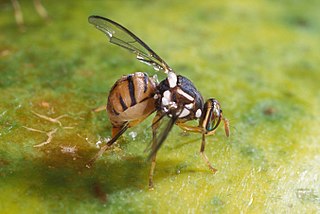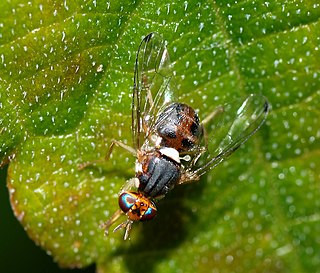
The Tephritoidea are a superfamily of flies. It has over 7,800 species, the majority of them in family Tephritidae.

Acidia is a small genus of flies in the family Tephritidae. It formerly contained many species, but by some authors has since been restricted to two.

Bactrocera is a large genus of tephritid fruit flies, with close to 500 species currently described and accepted.

The Dacinae are a subfamily of the fruit fly family Tephritidae. Its 41 genera are distributed among three tribes:
The Tachiniscinae are a subfamily of the fruit fly family Tephritidae. They are treated by some authorities as a separate family, Tachiniscidae. An undetermined species of the genus Tachiniscidia has been reared from Saturniidae caterpillars in Nigeria.
The Blepharoneurinae are a subfamily of the fruit fly family Tephritidae comprising five genera and 34 species.

Campiglossa is a genus of fruit flies in the family Tephritidae. There are at least 190 described species in Campiglossa.
Ceratodacus is a genus of tephritid fruitfly. The type species Ceratodacus longicornis is found in South America in Brazil, Guyana and Peru. Nothing is known about its host plant. A second species, Ceratodacus priscusNorrbom & Condon, 2000 has been described from Dominican amber.

Anastrepha is the most diverse genus in the American tropics and subtropics. Currently, it comprises more than 300 described species, including nine major pest species, such as the Mexican fruit fly, the South American fruit fly, the West Indian fruit fly, the sapote fruit fly, the Caribbean fruit fly, the American guava fruit fly, and the pumpkin fruit fly, as well as the papaya fruit fly. As some of their names suggest, these pest species are one of the most numerous and damaging groups of insects in their native range, plaguing commercial fruits such as citrus, mango, guava, and papaya.

Carpomya is a genus of tephritid or fruit flies in the family Tephritidae.

Zonosemata is a genus of tephritid or fruit flies in the family Tephritidae, comprising six species from North America and one from South America. The species are as follows:
Problepharoneura is a fossil genus of Tephritid or fruit flies in the family Tephritidae for the sole species, Problepharoneura antiqua, described on the basis of single male specimen found in Upper Eocene amber from the Dominican Republic.
Hemilea dimidiata is a species of tephritid or fruit flies in the genus Hemilea of the family Tephritidae.

Goniglossum wiedemanni is a species of tephritid or fruit flies in the family Tephritidae, and the only species in the genus Goniglossum.
Spinicosta is a genus of the family Tephritidae, better known as fruit flies.
Euarestoides is a genus of the family Tephritidae. The genus contains six species.
Trupanodesis is a genus of tephritid or fruit flies in the family Tephritidae.

Tephritini is a tribe of fruit flies in the family Tephritidae. There are about 80 genera and some 1000 described species in Tephritini.

Myopitini is a tribe of tephritid or fruit flies in the family Tephritidae.
Freidbergia mirabilis is a species of tephritid or fruit flies in the genus Freidbergia of the family Tephritidae.










